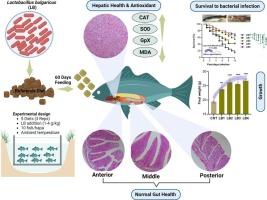Enhanced growth, antioxidant responses and resilience to Vibrio alginolyticus induced by Lactobacillus bulgaricus supplementation in Liza ramada
IF 3.9
1区 农林科学
Q1 FISHERIES
引用次数: 0
Abstract
This study tested five diets supplemented with Lactobacillus bulgaricus (LB; 0, 1, 2, 3, and 4 g/kg) (designated as CNT, LB LB1, LB2, LB3, and LB4) with the basal diet on growth, antioxidant capacity, hepatic and intestinal histoarchitecture, and resistance of Liza ramada to Vibrio alginolyticus infection. Fish (8.47 ± 0.40 g) were stocked in triplicate groups in hapas fixed in cement ponds and fed on freshly prepared test diets for 60 days. Fish-fed LB-supplemented diets demonstrated higher final weight (FBW), and specific growth rate (SGR) compared to the CNT group (ANOVA P < 0.0001), with the cubic trend for FBW and quadratic trend for SGR, as analyzed by the polynomial model. Similarly, higher feed intake and feed conversion ratio were found in groups fed LB-supplemented diets with a strong cubic trend with increasing dietary LB levels. The hepatic SOD (superoxide dismutase) and CAT (catalase) enzyme activities improved significantly in all LB groups while a significant increase in GPx (glutathione peroxidase) enzyme activity and decrease in MDA (malondialdehyde) levels were found in all dietary groups, except LB1 when compared to those fed CNT diet. The hepatic antioxidant responses were well fit with all polynomial models, but the cubic fit was highly significant in response to dietary LB levels. The intestinal and hepatic histoarchitecture showed normal and healthy structures across all treatments. The fish survival rate (55–70 %) improved significantly in fish fed 2–4 g/kg LB compared to the CNT group (15 %). To conclude, a dietary dose of 2–4 g/kg can be supplemented to bolster the infection resistance against pathogenic bacteria by enhancing growth, feed utilization, and antioxidant responses, potentiating its application as a functional additive to maximize the profitability of mullet farming.

添加保加利亚乳杆菌对丽扎鱼生长、抗氧化反应和抗溶藻弧菌能力的增强
本试验在基础饲粮中添加保加利亚乳杆菌(LB; 0、1、2、3和4 g/kg)(分别为CNT、LB LB1、LB2、LB3和LB4),研究了5种饲粮中保加利亚乳杆菌的生长、抗氧化能力、肝脏和肠道组织结构以及对溶藻弧菌感染的抗性。将鱼(8.47±0.40 g)分3组放养在水泥池固定的鱼池中,用新配制的试验饲料饲喂60 d。与CNT组相比,添加lb的鱼饲料表现出更高的最终体重(FBW)和特定生长率(SGR)(方差分析P <; 0.0001),通过多项式模型分析,FBW呈三次趋势,SGR呈二次趋势。同样,随着饲粮LB水平的升高,饲粮中添加LB组的采食量和饲料系数均呈较高的立方趋势。与CNT饲粮相比,各LB组肝脏超氧化物歧化酶(SOD)和过氧化氢酶(CAT)活性均显著提高,GPx(谷胱甘肽过氧化物酶)活性显著升高,MDA(丙二醛)水平显著降低(LB1除外)。肝脏抗氧化反应与所有多项式模型拟合良好,但对饲粮LB水平的响应具有极显著的三次拟合。各治疗组肠、肝组织结构正常、健康。与CNT组(15%)相比,2-4 g/kg LB组鱼的存活率(55 - 70%)显著提高。综上所述,饲粮中添加2-4 g/kg的添加量可通过促进生长、饲料利用率和抗氧化反应来增强对病原菌的感染抵抗力,从而促进其作为功能性添加剂的应用,最大限度地提高鲻鱼养殖的盈利能力。
本文章由计算机程序翻译,如有差异,请以英文原文为准。
求助全文
约1分钟内获得全文
求助全文
来源期刊

Aquaculture
农林科学-海洋与淡水生物学
CiteScore
8.60
自引率
17.80%
发文量
1246
审稿时长
56 days
期刊介绍:
Aquaculture is an international journal for the exploration, improvement and management of all freshwater and marine food resources. It publishes novel and innovative research of world-wide interest on farming of aquatic organisms, which includes finfish, mollusks, crustaceans and aquatic plants for human consumption. Research on ornamentals is not a focus of the Journal. Aquaculture only publishes papers with a clear relevance to improving aquaculture practices or a potential application.
 求助内容:
求助内容: 应助结果提醒方式:
应助结果提醒方式:


